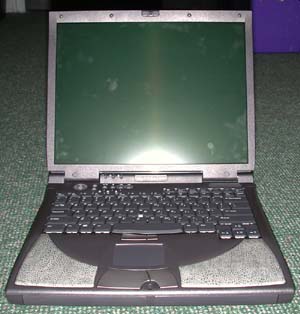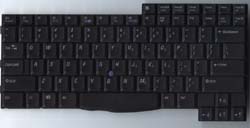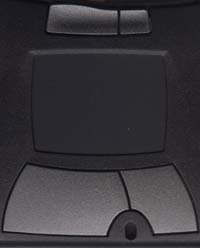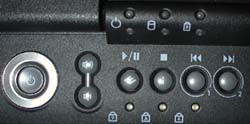Dell Inspiron 8200 Pentium 4-M 2.0GHz
by Matthew Witheiler on October 23, 2002 4:29 AM EST- Posted in
- Laptops
Construction - Build, Appearance, Size
The Dell Inspiron series notebooks have been around for a number of years now and have become Dell's staple high performance notebook. The Inspiron series is actually very similar to the business class Latitude series; the major difference between the two being the frequency which hardware and software modifications are made to the systems. While the Inspiron typically benefits from new drivers and updated hardware on a regular basis, the Latitude computers are more conservative as to prevent IT headaches resulting from a frequently changing line of PCs. The Inspiron 8200 that we got our hands on was a clear demonstrate of Dell's commitment to new technology: the notebooks featured almost every high-end component available for mobile systems.
The styling of the Inspiron 8200 is fairly conservative. The three spindle body maintains the look that previous Inspiron models had. The outer casing is plastic in its entirety with metal accents on the top of the notebook for the Dell and Inspiron logos. The casing is almost uniformly black accented with gray buttons and configurable color palm rest inserts. Any current or former Dell notebook owner should feel right at home with the Inspiron 8200's design.
The system is opened by pushing in on a small latch on the Inspiron 8200's screen. The locking mechanism is simple and seems to do a good job of keeping the unit closed when not in use. Releasing the latch and opening up the Inspiron 8200 gives access to the nicest LCD panel we have seen yet on a laptop. Our Dell Inspiron 8200 came with a 15.0" Dell UltraSharp UXGA LCD monitor which is Dell's highest end mobile display panel. The UltraSharp UXGA TFT LCD panel offers superior brightness, contrast ratio, response time, and viewing angles compared to standard UXGA panels. The 1600x1200 SuperSharp screen features a brightness rating of 180 cd/m^2 compared to a 150 CD/m^2 brightness rating of Dell's standard UXGA panel. The horizontal and vertical viewing angles are greatly improved over the standard panel (+/- 70 degrees vs +/- 40 degrees in the horizontal, +50/-60 degrees Vs +10/-30 degrees in the vertical) as is the contrast ratio (400:1 Vs 250:1). The numbers look impressive on paper but in order to truly appreciate the Dell UltraSharp display it has to be seen in person. The 15" UltraSharp display running at 1600x1200 is a thing of beauty and is well worth the $50 extra that it costs over a standard UXGA display.
Below the 15" display lies the Inspiron's keyboard: a full featured 85-key keyboard with dedicated arrow keys. They keyboard has a great feel. Thanks to the unit's large size key travel is plentiful. We found the keyboard layout very comfortable as it is very similar to the layout of a standard desktop keyboard. The keyboard also features an integrated pointing stick as a second input method. The pointing stick is located between the bottom of the G and H keys and right above the B key. The pointing stick also features its own set of buttons below the space bar. The pointing stick is a nice feature to have since it provides an alternative to the touchpad that most notebooks come with.
The Inspiron 8200 also comes with a fairly standard touchpad. The touchpad surface area proved to be spacious and the large buttons made clicking easy. The one complaint we had with the touchpad configuration on the Inspiron 8200 is the lack of a dedicated scroll button. We have seen a number of notebooks from Compaq, Sony, WinBook, and more that incorporate a scroll button into the touchpad allowing for at least vertical scroll and occasionally horizontal scrolling. With the large size of the Inspiron 8200's mouse buttons it does not seem that reserving some of this area for a scroll button would be all too hard.
To give the Inspiron 8200 a personalized touch, the system offers palm rest color inserts. The system comes standard with silver palm rests which can be replaced at any time in the computer's life by simply popping the existing inserts out and putting new ones in. The inserts have a soft rubber texture to them much like the palm rest area on the Compaq Presario series notebooks, making the rests comfortable. Our system came with silver alligator skin patterned inserts, one of eight inserts currently offered by Dell.
Above the keyboard lie the Inspiron 8200's function keys and status LEDs. There are a total of seven function buttons, beginning with the power button of the left followed by volume up and volume down buttons. The remaining 4 buttons can be set to operate in one of two modes via software. In application mode, the first button launches the Dell support page, the second button launches the default Internet browser, and the last two buttons can be programed to run any .EXE program file. In CD/DVD mode the buttons perform the functions pictured above them: button one play/pause, button two stop, button three track back, and button four track forward.
Below the function buttons are the keyboard status lights: num lock, caps lock, and scroll lock. There are also a set of LEDs above the keys, one for power status (solid when on, blinking while in standby), one for hard drive activity (on while hard drive is being accessed), and one for battery status (blinking while charging). There are two windows from which the top set of LEDs can be seen, a set on the inside panel and a set on the top of the laptop. This allows the LEDs to be seen while the screen is both closed and open.
The internal speaker on the Inspiron 8200 is found to the left of the power button. This should prove to be an effective location, as it is fairly far from where the hands rest while using the keyboard or touchpad.
On the far right side above the keyboard is a metal grill area. This serves to provide airflow across the CPU heatsink surface, as cool air drawn in from both this vent and a vent on the system's right side pass over the CPU heatsink and exit out the back.














1 Comments
View All Comments
Anonymous User - Monday, July 7, 2003 - link
I have had this pc for about six months now, and I am still in awe. My setup was not as good as the test model here, my processor is a 1.7 GHz and only 384Mb ram and the ATI 9000. I use this laptop for web surfing and internet gaming, mainly Diablo II(HC). This machine ROX.....